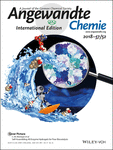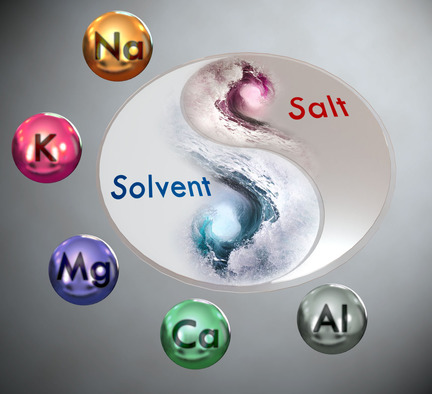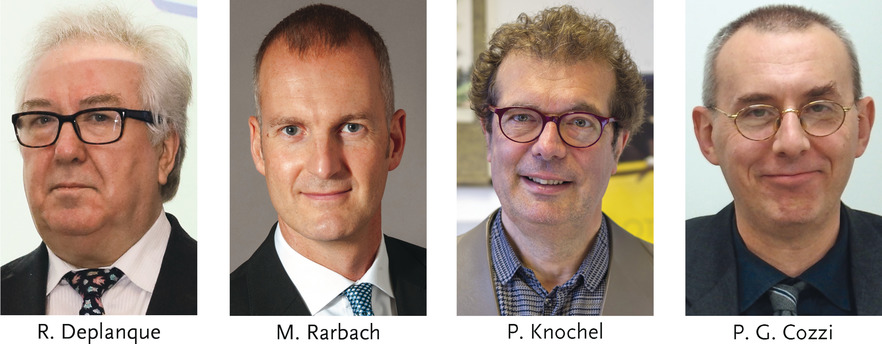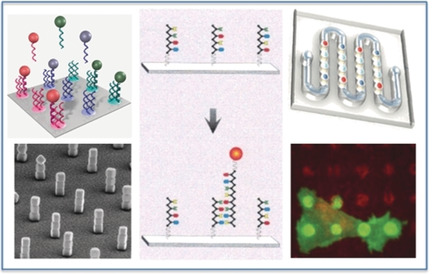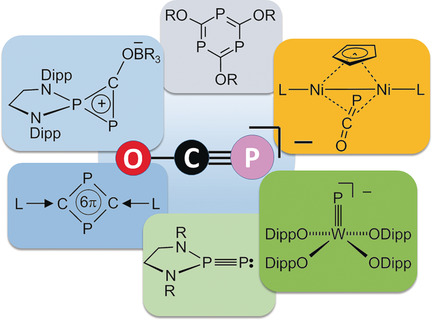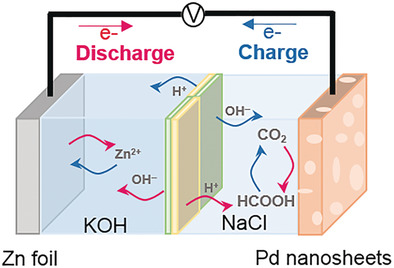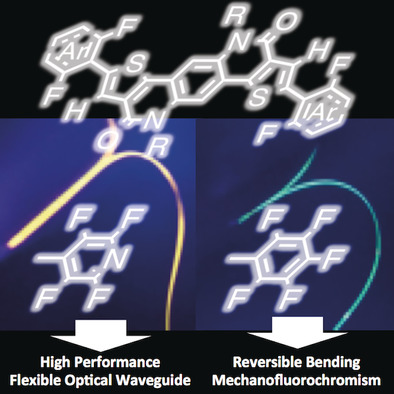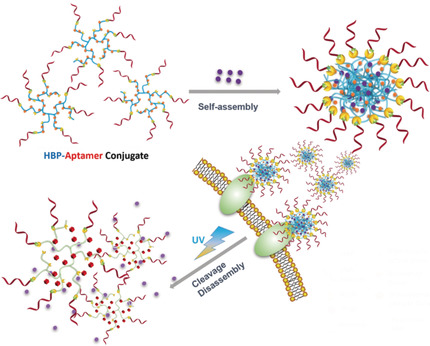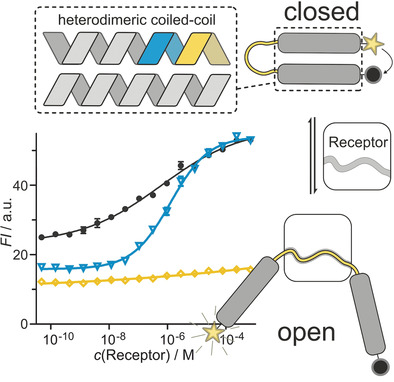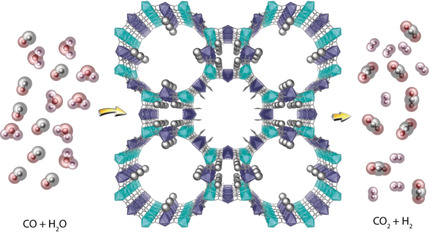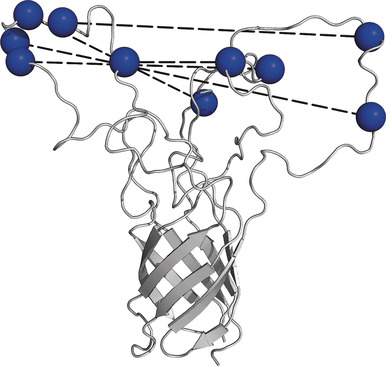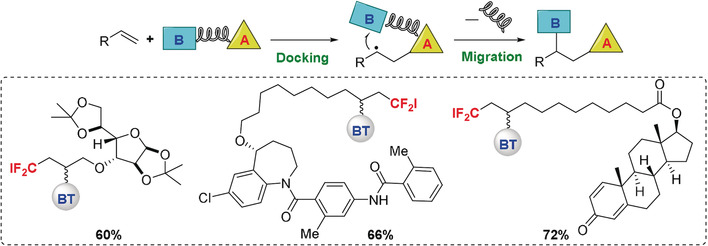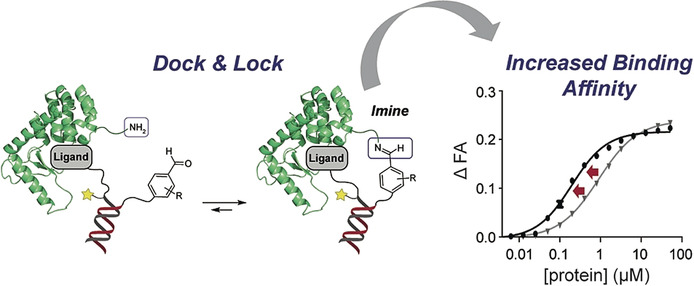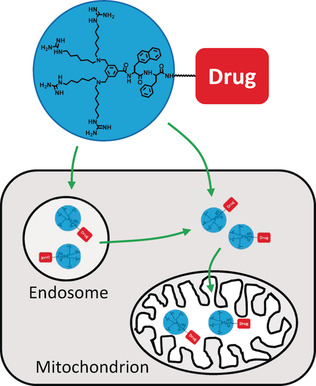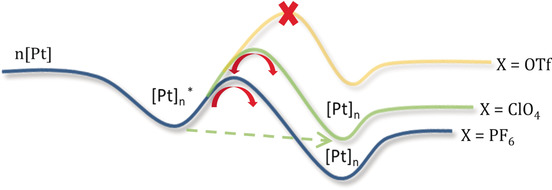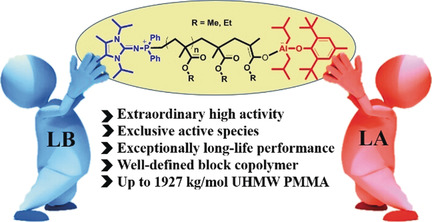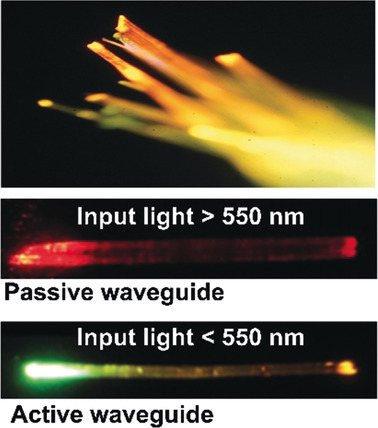Journal list menu
Export Citations
Download PDFs
Cover Pictures
Cover Picture: Self-Assembling All-Enzyme Hydrogels for Flow Biocatalysis (Angew. Chem. Int. Ed. 52/2018)
- Page: 16909
- First Published: 28 November 2018
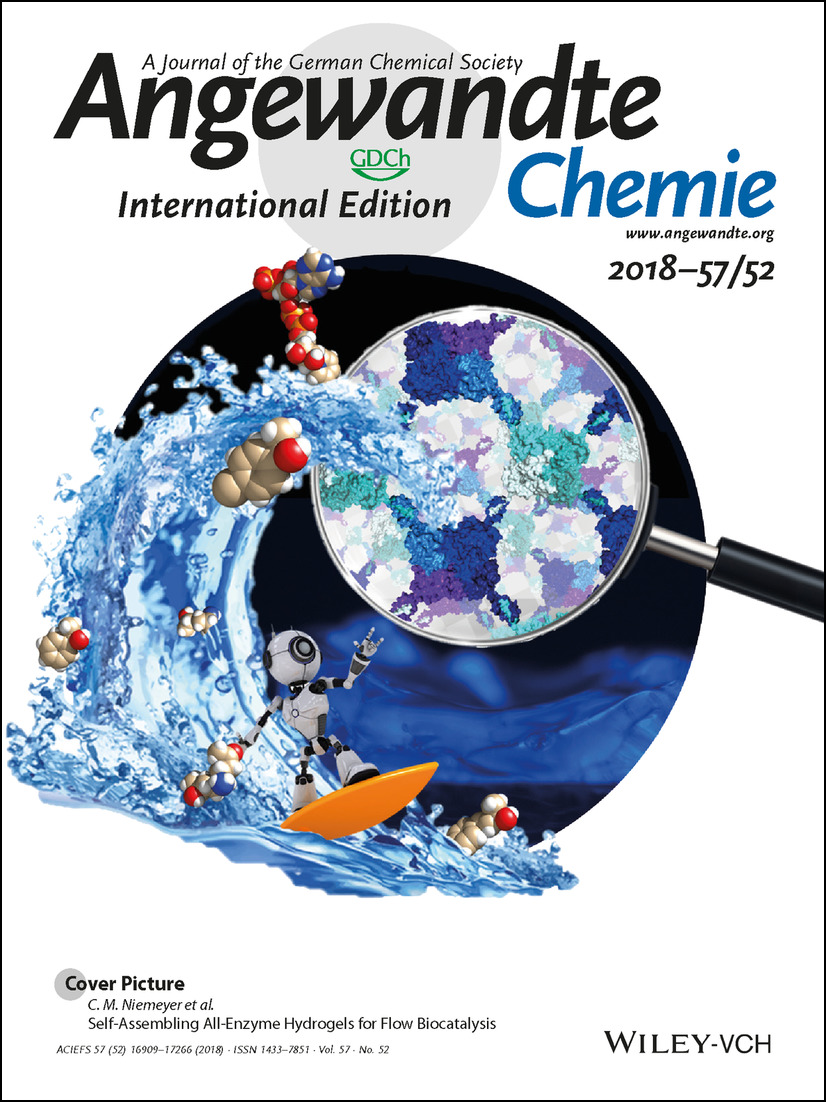
The next wave of biocatalysis will be enabled by machine-assisted flow processes that require tailor-made materials to achieve efficient product conversion. In their Communication on page 17028 ff., C. M. Niemeyer and co-workers describe self-assembling all-enzyme hydrogels that are made from two cooperating enzymes and can be produced in macroscopic quantities (blue background image). Mounted in microfluidic reactors, the gels show excellent stereoselectivity with near quantitative conversion in the reduction of ketones along with extraordinary high turnover of expensive cofactors.
Inside Cover: Creating Elastic Organic Crystals of π-Conjugated Molecules with Bending Mechanofluorochromism and Flexible Optical Waveguide (Angew. Chem. Int. Ed. 52/2018)
- Page: 16910
- First Published: 30 November 2018

Functional organic crystals with elastic flexibility can be applied in high-performance fluorescent waveguides and reversible mechanofluorosensors. In their Communication on page 17002 ff., S. Hayashi, K. Takagi et al. show that a slight modification of the terminal group results in a dramatic change of the optical functions.
Inside Back Cover: Coiled-Coil Peptide Beacon: A Tunable Conformational Switch for Protein Detection (Angew. Chem. Int. Ed. 52/2018)
- Page: 17265
- First Published: 04 December 2018
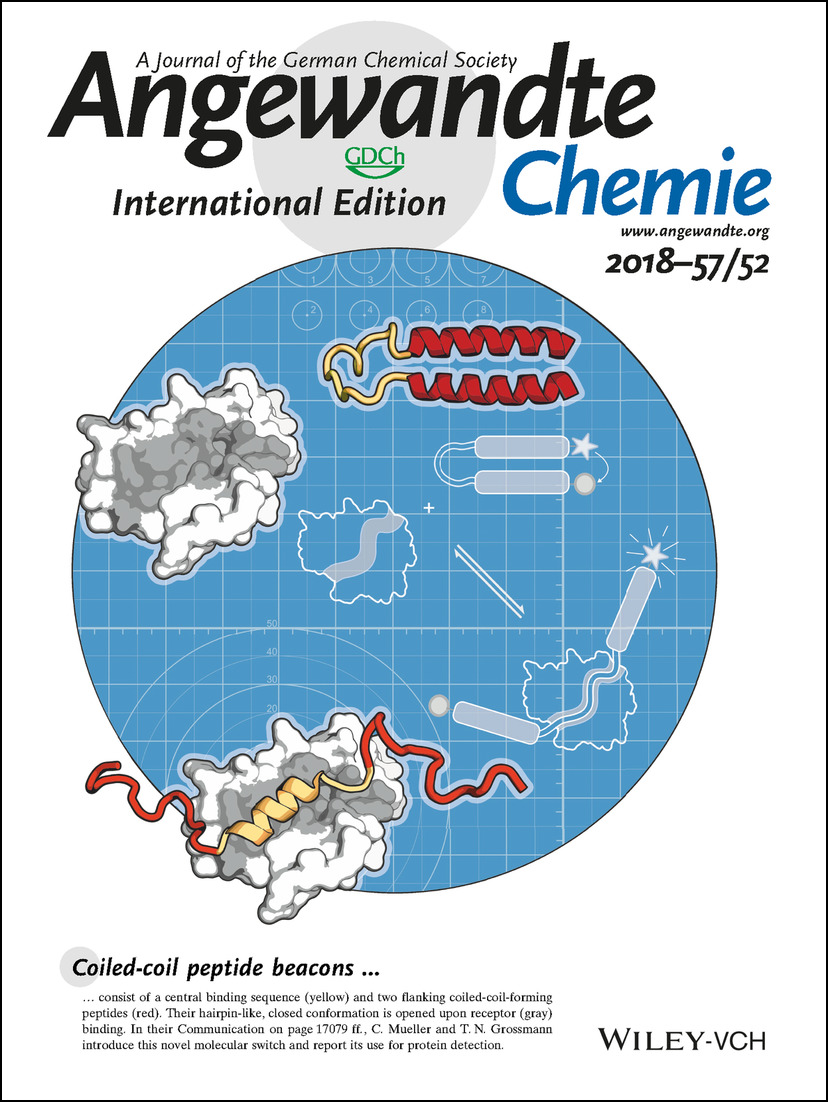
Coiled-coil peptide beacons consist of a central binding sequence (yellow) and two flanking coiled-coil-forming peptides (red). Their hairpin-like, closed conformation is opened upon receptor (gray) binding. In their Communication on page 17079 ff., C. Mueller and T. N. Grossmann introduce this novel molecular switch and report its use for protein detection.
Back Cover: Experimentally Calibrated Analysis of the Electronic Structure of CuO+: Implications for Reactivity (Angew. Chem. Int. Ed. 52/2018)
- Page: 17266
- First Published: 04 December 2018
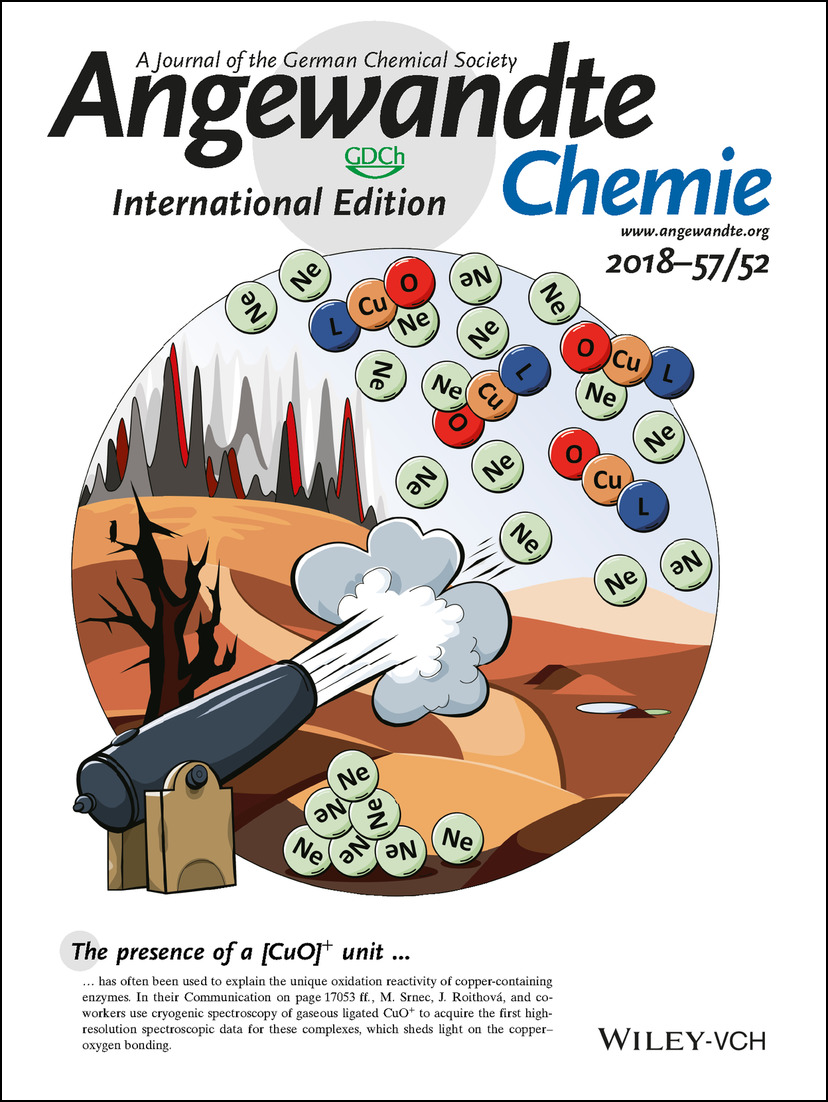
The presence of a [CuO]+ unit has often been used to explain the unique oxidation reactivity of copper-containing enzymes. In their Communication on page 17053 ff., M. Srnec, J. Roithová, and co-workers use cryogenic spectroscopy of gaseous ligated CuO+ to acquire the first high-resolution spectroscopic data for these complexes, which sheds light on the copper–oxygen bonding.
Frontispiece
Frontispiece: Reversible Aqueous Zinc–CO2 Batteries Based on CO2–HCOOH Interconversion
- First Published: 18 December 2018
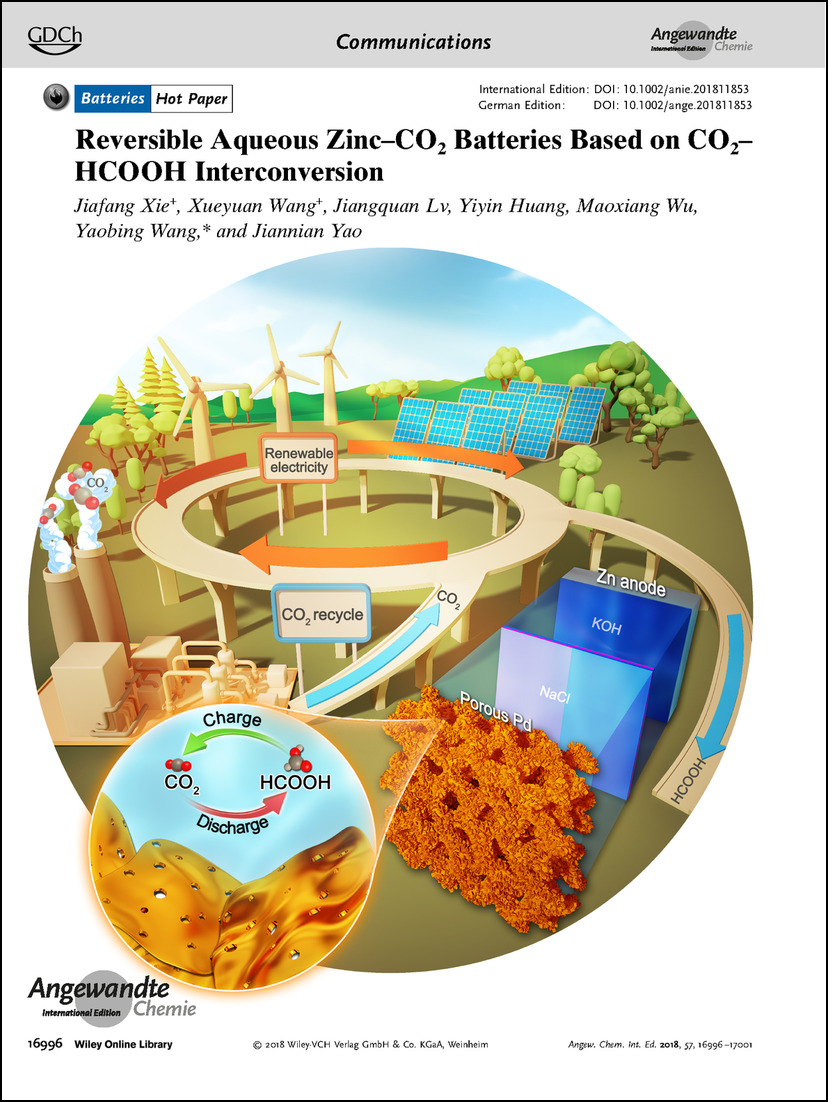
Zinc–CO2 Batteries. A reversible aqueous Zn–CO2 battery is prepared by Y. Wang et al. in their Communication on page 16996 ff. 3D porous Pd interconnected nanosheets act as the cathode and electrocatalyze CO2 reduction and HCOOH oxidation.
Graphical Abstract
Graphical Abstract: Angew. Chem. Int. Ed. 52/2018
- Pages: 16913-16929
- First Published: 18 December 2018
Corrigenda
Corrigendum: Digging the Sigma-Hole of Organoantimony Lewis Acids by Oxidation
- Page: 16929
- First Published: 18 December 2018
News
Spotlights on our sister journals: Angew. Chem. Int. Ed. 52/2018
- Pages: 16930-16934
- First Published: 18 December 2018
Author Profile
News
Gmelin–Beilstein Memorial Medal: R. Deplanque / Meyer-Galow Prize: M. Rarbach / International Prizes from the Real Sociedad Española de Química: P. Knochel and P. G. Cozzi
- Page: 16937
- First Published: 28 November 2018
Editorial Board and International Advisory Board: 52/2018
- Pages: 16939-16941
- First Published: 18 December 2018
Highlights
Vinyl Cations
Are Vinyl Cations Finally Coming of Age?
- Pages: 16942-16944
- First Published: 25 November 2018

Ready for the open waters? Recent developments have fundamentally changed our knowledge of vinyl cation reactivity. The myth that they are too reactive for a predictable reaction design has been debunked, and the applicability of their most distinguished feature, namely their carbene-like reactivity, has taken a major leap forwards. Vinyl cations have thus matured into distinct reactive intermediates with a bright future ahead.
Minireviews
Medical Devices
Advances in Materials and Structures for Ingestible Electromechanical Medical Devices
- Pages: 16946-16958
- First Published: 12 July 2018

Ingestible medical devices could significantly improve human health. Recent examples of ingestible biomedical devices include edible cameras, biosensors, and drug delivery systems. This Minireview summarizes recent advances in materials, structures, fabrication techniques, and systems integration, which are relevant to the design of next-generation ingestible biomedical devices. (Picture adapted from Bonacchini et al., Adv. Mat. 2018.)
DNA Nanotechnology
DNA Surface Technology: From Gene Sensors to Integrated Systems for Life and Materials Sciences
- Pages: 16959-16967
- First Published: 15 November 2018
Reviews
Phosphaethynolate
Communications
Batteries | Hot Paper
Reversible Aqueous Zinc–CO2 Batteries Based on CO2–HCOOH Interconversion
- Pages: 16996-17001
- First Published: 30 October 2018
Elastic Organic Crystals
Creating Elastic Organic Crystals of π-Conjugated Molecules with Bending Mechanofluorochromism and Flexible Optical Waveguide
- Pages: 17002-17008
- First Published: 19 October 2018
Biosynthesis
Trapping the Complex Molecular Machinery of Polyketide and Fatty Acid Synthases with Tunable Silylcyanohydrin Crosslinkers
- Pages: 17009-17013
- First Published: 31 October 2018
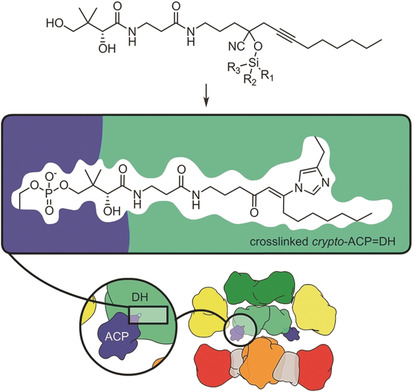
Mechanism-based crosslinking is a vital tool to trap states within multimodular enzymatic systems. A caged system is described that applies silylcyanohydrin chemistry to mask a reactive ketone warhead. Given the diversity of different silyl groups, this system can be tuned to deliver high yields of protein–protein crosslinking as defined in the context of large polyketide and fatty acid synthases.
Ultrafast Spectroscopy
Transient Glass Formation around a Quadrupolar Photoexcited Dye in a Strongly H-Bonding Liquid Observed by Transient 2D-IR Spectroscopy
- Pages: 17014-17018
- First Published: 02 November 2018

Frozen but not for long: A few picoseconds after its excitation, a quadrupolar dye forms a tight and asymmetric hydrogen-bond complex with the solvent. Transient 2D-IR spectroscopy reveals that this results in a dramatic slowing down of the solvent dynamics on one side of the dye. The surrounding solvent exhibits a glass-like behavior.
Organic Electronics
Dipole-Switchable Poly(para-phenyleneethynylene)s: Ferroelectric Conjugated Polymers
- Pages: 17019-17022
- First Published: 07 November 2018
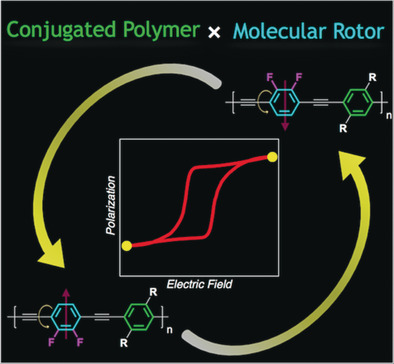
Polarized polymers: Dipolar 2,3-difluorobenzene units are introduced into the backbone of PPE. The difluorinated benzene rings behave as molecular rotors at high temperature, while at room temperature, stacking of such rings clamps the ring orientation to generate a remanent polarization. The molecular dipoles are oriented by moderate external electrical fields, and this PPE is then a ferroelectric conjugated polymer.
Proton Transfer
Damaging Intermolecular Energy and Proton Transfer Processes in Alpha-Particle-Irradiated Hydrogen-Bonded Systems
- Pages: 17023-17027
- First Published: 12 November 2018
Flow Biocatalysis
Self-Assembling All-Enzyme Hydrogels for Flow Biocatalysis
- Pages: 17028-17032
- First Published: 31 October 2018
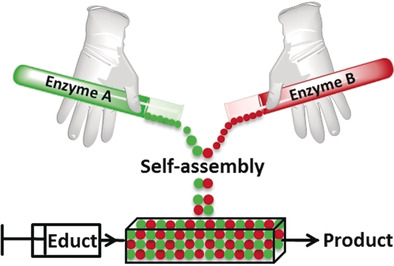
Hydrogels comprised entirely of enzymes self-assemble under physiological conditions by covalent SpyTag/SpyCatcher interaction to porous hydrogels. Mounted in microfluidic reactors, the gels exhibit excellent stability, stereoselectivity, and cofactor retention without the need for additional carriers or membranes.
Homogeneous Catalysis
Pyranopterin Related Dithiolene Molybdenum Complexes as Homogeneous Catalysts for CO2 Photoreduction
- Pages: 17033-17037
- First Published: 13 November 2018

Two original dithiolenes, mimicking molybdopterin (MPT) present in the active site of formate dehydrogenases (FDHs), have been synthesized and characterized. MoO(dithiolene)2 complexes have been also prepared and are reported as the first functional and stable catalysts inspired by the Mo center of FDHs: they indeed catalyze the photoreduction of CO2 into formic acid as the major product.
Macrocycles
Reversible Photoisomerization of Monolayers of π-Expanded Oligothiophene Macrocycles at Solid–Liquid Interfaces
- Pages: 17038-17042
- First Published: 31 October 2018
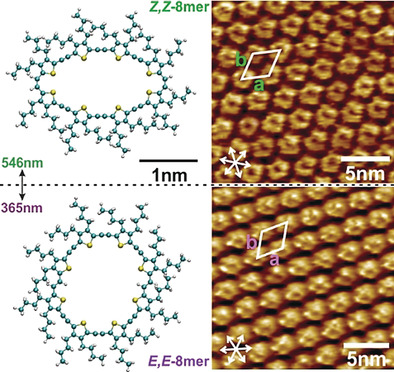
Self-assembled monolayers of the π-expanded macrocyclic isomers Z,Z-8mer and E,E-8mer at solid–liquid interfaces undergo reversible in situ photoisomerization upon irradiation with UV/visible light. Given the host–guest capabilities of these macrocycles, these results reveal their potential for photoresponsive cargo delivery systems.
Protein Degradation
Selective Degradation of Polo-like Kinase 1 by a Hydrophobically Tagged Inhibitor of the Polo-Box Domain
- Pages: 17043-17047
- First Published: 23 October 2018
Drug Delivery
Self-Assembled Aptamer-Grafted Hyperbranched Polymer Nanocarrier for Targeted and Photoresponsive Drug Delivery
- Pages: 17048-17052
- First Published: 02 November 2018
Photodissociation Spectroscopy
Experimentally Calibrated Analysis of the Electronic Structure of CuO+: Implications for Reactivity
- Pages: 17053-17057
- First Published: 14 November 2018

Excited CuO: Franck–Condon analysis of vibrationally resolved photodissociation uncovered the complex structure of acetonitrile-supported CuO+ species with several triplet excited states. Benchmarked multireference theoretical calculations explain how the character of the Cu−O bond shifts from copper(I)-oxygen towards copper(II)-oxyl in ligated systems.
Reaction Monitoring | Hot Paper
Concentrating Immiscible Molecules at Solid@MOF Interfacial Nanocavities to Drive an Inert Gas–Liquid Reaction at Ambient Conditions
- Pages: 17058-17062
- First Published: 01 November 2018

Gas–liquid reactions form the basis of our lives, yet they suffer from poor reaction efficiency and are difficult to monitor in situ, especially at ambient conditions. An inert gas–liquid reaction between aniline and CO2 is driven at 1 atm and 298 K. Real-time reaction monitoring was performed by selectively concentrating these immiscible reactants at the interface between metal–organic framework and solid nanoparticles.
Thermoelectricity | Hot Paper
Tin Diselenide Molecular Precursor for Solution-Processable Thermoelectric Materials
- Pages: 17063-17068
- First Published: 06 November 2018
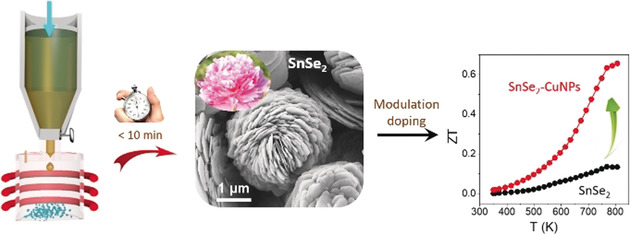
Thermoelectrics: A fast and simple solution-based method is presented to synthesize flower-like SnSe2 nanostructures and crystallographically textured SnSe2 nanomaterials, which display highly anisotropic charge and heat transport properties. Unprecedented thermoelectric performance of SnSe2 is achieved through modulation doping by combining SnSe2 nanoplates with metal nanoparticles.
Parkinson's Disease
Segmental 13C-Labeling and Raman Microspectroscopy of α-Synuclein Amyloid Formation
- Pages: 17069-17072
- First Published: 29 October 2018
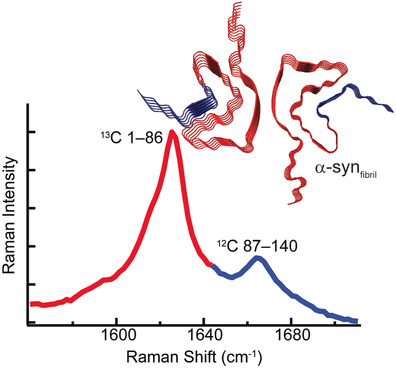
Two peaks are better than one: Native chemical ligation was used to segmentally label α-synuclein with 13C. This labeling results in two spectroscopically distinct amide-I bands that independently report on region-specific conformational changes of the protein backbone. The N-terminal region was seen to adopt a β-sheet structure first in the formation of amyloid.
Peptidomimetics
A Solid-Phase Approach to Accessing Bisthioether-Stapled Peptides Resulting in a Potent Inhibitor of PRC2 Catalytic Activity
- Pages: 17073-17078
- First Published: 19 October 2018

The chemoselective ligation of cysteine residues on a solid phase using a variety of aliphatic electrophiles is achieved by a new stapling method. This approach can be applied to the preparation of single-turn, double-turn, and double-stapled peptides. Its application has led to the identification of a potent inhibitor of the catalytic activity of the polycomb-repressive group of proteins (PRC2).
Molecular Devices | Hot Paper
Coiled-Coil Peptide Beacon: A Tunable Conformational Switch for Protein Detection
- Pages: 17079-17083
- First Published: 09 November 2018
Antitumor Therapy
Amino Acid Coordination Driven Self-Assembly for Enhancing both the Biological Stability and Tumor Accumulation of Curcumin
- Pages: 17084-17088
- First Published: 23 October 2018
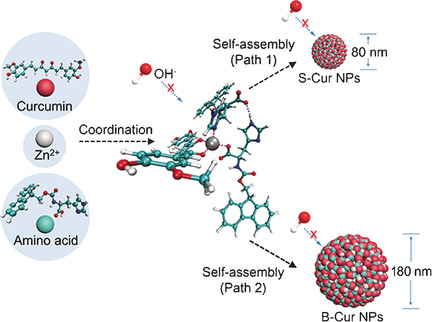
Special agents on the job: Supramolecular curcumin nanoagents were fabricated by amino acid coordination driven self-assembly (see picture). The biological stability of curcumin was significantly improved through both coordination and molecular stacking in the nanoagents, the size of which could be readily manipulated. These favorable therapeutic features substantially enhanced the antitumor activity of curcumin without discernible side effects.
Magnetic Properties
A Dy4 Cubane: A New Member in the Single-Molecule Toroics Family
- Pages: 17089-17093
- First Published: 09 November 2018
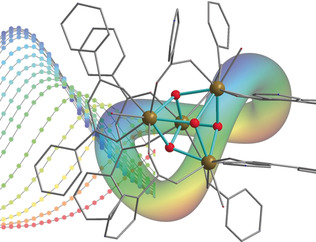
3D magnetic toroics: Molecular materials that have a toroidal moment associated to a non-magnetic ground state are known as single-molecule toroics (SMTs) and are usually planar molecules. Such a toroidal moment is observed in a Dy4 cubane, transposing this property to a tridimensional structure (3D-SMT).
Single-Atom Catalysts
Confined Pt11+ Water Clusters in a MOF Catalyze the Low-Temperature Water–Gas Shift Reaction with both CO2 Oxygen Atoms Coming from Water
- Pages: 17094-17099
- First Published: 06 November 2018
Organocatalysis
N-Heterocyclic Carbene Catalyzed Quadruple Domino Reactions: Asymmetric Synthesis of Cyclopenta[c]chromenones
- Pages: 17100-17103
- First Published: 05 November 2018
![N-Heterocyclic Carbene Catalyzed Quadruple Domino Reactions: Asymmetric Synthesis of Cyclopenta[c]chromenones](/cms/asset/911c5d16-dbf5-4c20-8c28-3aacd42e38cd/anie201810402-toc-0001-m.jpg)
Via acyl azoliums: A quadruple domino sequence proceeding via α,β-unsaturated acyl azolium intermediates is catalyzed by an N-heterocyclic carbene. This strategy provides a convenient direct route to functionalized tricyclic chromenone derivatives and cyclopentanes. DFT studies and control experiments provide insight into the reaction mechanism.
Dissolution
Pyridinethiol-Assisted Dissolution of Elemental Gold in Organic Solutions
- Pages: 17104-17109
- First Published: 29 October 2018
Molecular Dynamics
Refinement of Highly Flexible Protein Structures using Simulation-Guided Spectroscopy
- Pages: 17110-17114
- First Published: 05 November 2018
Self-Assembly | Hot Paper
Aqueous Phase Phosphorescence: Ambient Triplet Harvesting of Purely Organic Phosphors via Supramolecular Scaffolding
- Pages: 17115-17119
- First Published: 30 October 2018

Aqueous phosphorescence: An unprecedented organic-inorganic hybrid co-assembly approach is proposed to obtain aqueous state as well as amorphous red-emitting room temperature phosphorescence. Heavy-atom effect in the NDI derivative along with its J-aggregation enhance the intersystem crossing efficiency whereas rigid and oxygen tolerant laponite templates stabilize the triplets.
Analytical Methods
Label-Free Visualization of Carbapenemase Activity in Living Bacteria
- Pages: 17120-17124
- First Published: 31 October 2018
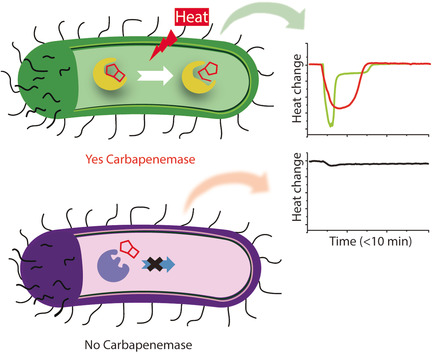
Heat of the moment: A label-free method for real-time monitoring of carbapenemase activity in live bacteria is based on measurement of heat changes induced by hydrolysis of the substrate imipenem. This in-cell calorimetry approach offers major advantages in rapid screening of carbapenemase-producing Enterobacteriaceae in clinical bacterial isolates, with superior sensitivity and excellent specificity compared to conventional methods.
Electrochemical Synthesis
Electrochemical Dimerization of Phenylpropenoids and the Surprising Antioxidant Activity of the Resultant Quinone Methide Dimers
- Pages: 17125-17129
- First Published: 26 November 2018

Quinone methide dimers are prepared via mild anodic oxidation mediated by a cheap and readily available amine base with excellent yield and regiocontrol. This strategy provides rapid access to intermediates for the synthesis of phenylpropenoid oligomers in a catalytic fashion, providing a new tool for the total synthesis of these complex molecules.
MOF Membranes
Incorporation of Homochirality into a Zeolitic Imidazolate Framework Membrane for Efficient Chiral Separation
- Pages: 17130-17134
- First Published: 29 October 2018
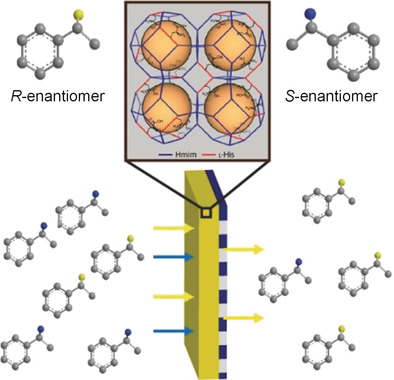
Handpicked: A homochiral zeolitic imidazolate framework-8 (ZIF-8) membrane was synthesized by incorporating a natural amino acid, l-histidine (l-His), into a ZIF framework. The amino acid functions as a chiral (enantiopure) ligand. The l-His-ZIF-8 membrane demonstrates good homochirality and an ability to separate racemic 1-phenylethanol with up to 76 % ee.
Electrocatalysis | Hot Paper
Ordered Mesoporous C3N5 with a Combined Triazole and Triazine Framework and Its Graphene Hybrids for the Oxygen Reduction Reaction (ORR)
- Pages: 17135-17140
- First Published: 08 November 2018
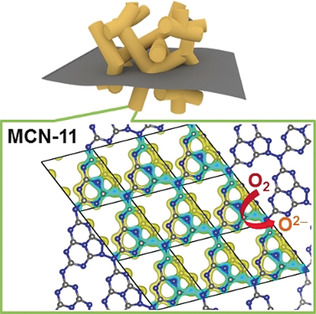
Triazole you might: In the oxygen reduction reaction (ORR) triazole-based C3N5 (MCN-11) and its graphene hybrids show significantly improved diffusion-limiting current density compared to g-C3N4. The enhanced activity is attributed to features of MCN-11 such as strong adsorption between O2 and active carbons in the triazole moiety.
Homochirality
Nebulization Prior to Isolation, Ionization, and Dissociation of the Neutral Serine Octamer Allows Its Characterization
- Pages: 17141-17145
- First Published: 29 October 2018

Neutral serine octamer: Nebulization coupled with gentle on-line protonation and MS analysis is used to isolate and characterize the neutral serine octamer (Ser8). Ser8 was transmitted from the nebulizer into the ionization region while any residual protonated octamer was deflected. Nebulized near-racemic serine solutions exhibited homochiral preference for the octamer, which is proposed to be the origin of the homochiral preference observed in Ser8H+.
Supramolecular Chemistry
Templating and Catalyzing [2+2] Photocycloaddition in Solution Using a Dynamic G-Quadruplex
- Pages: 17146-17150
- First Published: 05 November 2018
![Templating and Catalyzing [2+2] Photocycloaddition in Solution Using a Dynamic G-Quadruplex](/cms/asset/302c8e96-da17-421d-b4b2-3762cee2bc8e/anie201811202-toc-0001-m.jpg)
A templating/covalent capture strategy enables photochemical formation of eight cyclobutanes in one noncovalent assembly. KI and 16 units of 5′-cinnamate guanosine form a G-quadruplex where C=C bonds in neighboring G4-quartets are separated by 3.3 Å, enabling [2+2] photocycloaddition in solution. This reaction is high-yielding (>90 %), regio- and diastereoselective.
Homogeneous Catalysis
Pd-Catalyzed Atroposelective C−H Allylation through β-O Elimination: Diverse Synthesis of Axially Chiral Biaryls
- Pages: 17151-17155
- First Published: 09 November 2018
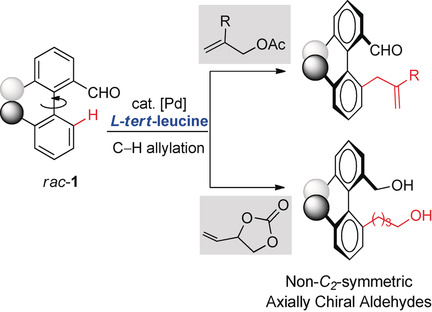
A Pd-catalyzed atroposelective C−H allylation with allylic surrogates is reported. tert-Leucine was identified as an efficient catalytic transient chiral auxiliary. A range of enantioenriched biaryls were prepared in synthetically useful yields with enantioselectivities up to >99 % ee through β-O elimination. The reaction could be scaled up and the products could be further converted into enantiomerically pure axially chiral carboxylic acids.
Difluoromethylation
Efficient Docking–Migration Strategy for Selective Radical Difluoromethylation of Alkenes
- Pages: 17156-17160
- First Published: 05 November 2018
Natural Product Synthesis
Asymmetric Total Synthesis of Brasilicardins
- Pages: 17161-17167
- First Published: 01 November 2018

One approach, four targets: The asymmetric total synthesis of brasilicardin A, a hybrid natural product with highly potent immunosuppressive activity, has been developed. The synthesis features a Michael addition based strategy for the stereoselective formation of the highly strained anti-syn-anti-fused perhydrophenanthrene skeleton, and brasilicardins B–D are also synthesized based on the unified approach.
Electrocatalysis
A Multi-Doped Electrocatalyst for Efficient Hydrazine Oxidation
- Pages: 17168-17172
- First Published: 12 November 2018
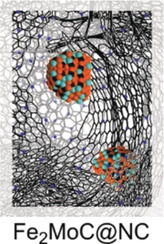
Cooperative active sites in nitrogen-cycle enzymes inspired the design of a multi-doped, efficient electrocatalyst for hydrazine oxidation. The catalytic oxidation occurs on Fe2MoC nanoparticles and on edge-positioned nitrogen dopants, all well-dispersed on a hierarchically porous, graphitic carbon matrix.
Water Splitting
A Noble-Metal-Free Heterogeneous Photosensitizer-Relay Catalyst Triad That Catalyzes Water Oxidation under Visible Light
- Pages: 17173-17177
- First Published: 05 November 2018
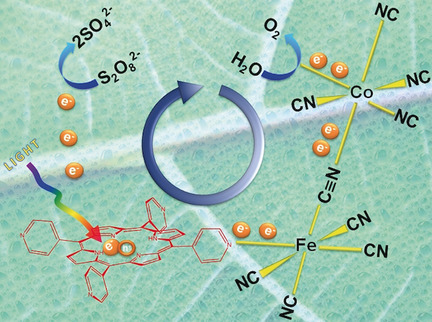
Relay races: An entirely earth-abundant chromophore-relay water oxidation catalyst triad system, which is robust and efficient at neutral pH, is presented. It involves a porphyrin derivative coordinating to a bridging Fe(CN)5 group, which is then reacted with Co ions to prepare a covalently linked chromophore–Prussian blue analogue assembly.
Medicinal Chemistry
Affinity Enhancement of Protein Ligands by Reversible Covalent Modification of Neighboring Lysine Residues
- Pages: 17178-17182
- First Published: 06 November 2018
Drug Delivery
Non-Peptidic Cell-Penetrating Motifs for Mitochondrion-Specific Cargo Delivery
- Pages: 17183-17188
- First Published: 30 October 2018
Supramolecular Polymers
Counteranion- and Solvent-Mediated Chirality Transfer in the Supramolecular Polymerization of Luminescent Platinum(II) Complexes
- Pages: 17189-17193
- First Published: 29 October 2018
Conformation Analysis
A Mass-Spectrometry-Based Modelling Workflow for Accurate Prediction of IgG Antibody Conformations in the Gas Phase
- Pages: 17194-17199
- First Published: 08 November 2018
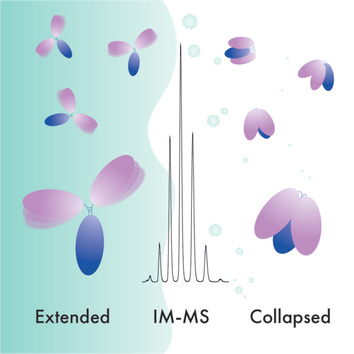
Not to be IgG-nored: An integrative strategy combining ion mobility mass spectrometry (IM-MS) with molecular modelling can be used to study the conformational dynamics of human IgG antibodies. Predictive models of all four human IgG subclasses were assembled and their dynamics sampled in the transition from extended to collapsed state during IM-MS. The structural representation is in good agreement with the observed collision cross sections.
Gold Catalysis
Enantioselective Oxidative Cyclization/Mannich Addition Enabled by Gold(I)/Chiral Phosphoric Acid Cooperative Catalysis
- Pages: 17200-17204
- First Published: 30 October 2018
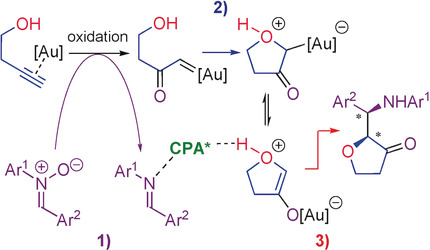
Golden oldie: A combination of gold(I) and chiral phosphoric acid (CPA) catalyzes a Mannich-type reaction cooperatively. Asymmetric trapping of a gold enolate intermediate involved in alkyne oxidations occurs via an α-oxo gold carbene route. Alkyne transformation involves 1) chemical N−O bond cleavage, 2) fragment modification, and 3) reassembly.
Branched Structures | Hot Paper
Creating Biomorphic Barbed and Branched Mesostructures in Solution through Block Copolymer Crystallization
- Pages: 17205-17210
- First Published: 24 October 2018
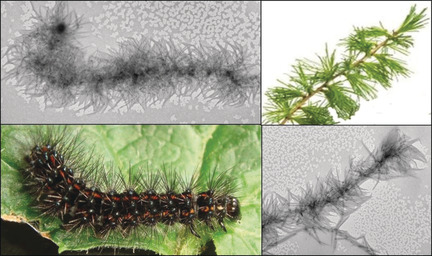
PFS-b-PI (poly(ferrocenyldimethylsilane)-block-polyisoprene) diblock copolymers self-assemble into biomorphic structures with shapes that depend on the assembly conditions. Long fiber-like micelles of uniform width are formed with a crystalline PFS core in decane. Injection of a THF polymer solution into THF/decane leads to micrometer-scale barbed and branched structures with shapes that depend upon the final THF content.
Point-of-Care Diagnostics
Valve-Enabled Sample Preparation and RNA Amplification in a Coffee Mug for Zika Virus Detection
- Pages: 17211-17214
- First Published: 24 October 2018

POC Zika detection: A valve-enabled lysis, paper-based RNA enrichment, and RNA amplification device (VLEAD) is designed for sample-to-answer Zika virus detection. RNA is enriched with VLEAD in 25 min. A colorimetric signal is generated with SYBR Green dye and a blue LED flashlight after 25 min of reverse transcription loop-mediated amplification (RT-LAMP).
C−H Activation
Intermolecular C(sp3)−H Amination Promoted by Internal Oxidants: Synthesis of Trifluoroacetylated Hydrazones
- Pages: 17215-17219
- First Published: 05 November 2018

An inside job: An intermolecular C(sp3)−H amination reaction is reported that is promoted by internal oxidants and is realized under mild conditions. Trifluoroacetylated hydrazones that are generated upon C=N bond formation are further transformed into various useful compounds decorated with a trifluoromethyl group.
Photocatalysis | Hot Paper
Visible-Light-Mediated Metal-Free Difunctionalization of Alkenes with CO2 and Silanes or C(sp3)−H Alkanes
- Pages: 17220-17224
- First Published: 08 November 2018
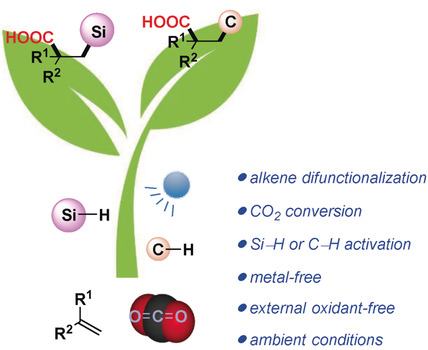
Photocarboxylation: Visible-light-promoted metal-free difunctionalization of alkenes using CO2 and readily available Si−H and C(sp3)−H reagents has been realized by the merging of photoredox and hydrogen-atom-transfer catalysis. A variety of valuable compounds, such as β-silacarboxylic acids and acids bearing a γ-heteroatom (e.g., N, O, S) can be directly accessed from simple alkenes in a redox-neutral fashion.
Cooperative Catalysis
A Cooperative Hydrogen Bond Donor–Brønsted Acid System for the Enantioselective Synthesis of Tetrahydropyrans
- Pages: 17225-17229
- First Published: 31 October 2018
Frustrated Lewis Pairs
Ultra-High-Molecular-Weight Polymers Produced by the Immortal Phosphine-Based Catalyst System
- Pages: 17230-17234
- First Published: 31 October 2018
Fluorescent Probes
Hierarchical Self-Assembly of BODIPY Dyes as a Tool to Improve the Antitumor Activity of Capsaicin in Prostate Cancer
- Pages: 17235-17239
- First Published: 16 October 2018
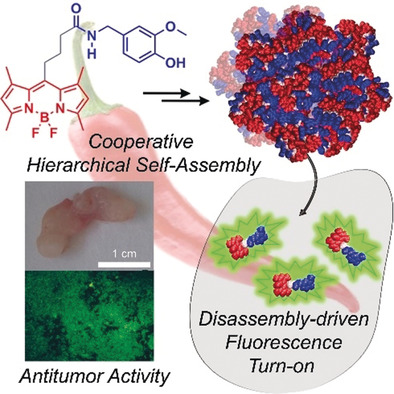
Spice up your life! Covalent attachment of a fluorescent BODIPY dye has been exploited to enhance the aggregation propensity of capsaicin—the major active component of chili peppers—in aqueous media. Due to the improved delivery of active capsaicin-based molecules to the tumour tissue upon aggregation, the effective doses for prostate cancer treatment could be successfully reduced by two orders of magnitude.
Cross-Coupling
Synthesis of Water-Soluble Blue-Emissive Tricyclic 2-Aminopyridinium Salts by Three-Component Coupling-(3+3)-Anellation
- Pages: 17240-17244
- First Published: 17 October 2018
Artificial Cells | Hot Paper
Artificial Gel-Based Organelles for Spatial Organization of Cell-Free Gene Expression Reactions
- Pages: 17245-17248
- First Published: 05 November 2018
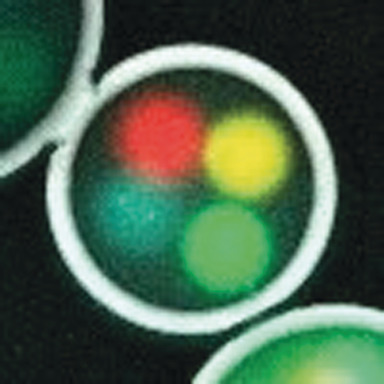
Chemical processes within biological cells often occur inside organelles. This high degree of intracellular organization has inspired the development of gel-based artificial organelles that enable sequence-specific and programmable localization of cell-free transcription and translation reactions inside an artificial cellular system.
Synthetic Methods
Mild Homologation of Esters through Continuous Flow Chloroacetate Claisen Reactions
- Pages: 17249-17253
- First Published: 05 October 2018

A highly chemoselective chloromethylenation of functionalized esters using (di)chloroacetic acid and LiHMDS was carried out in a continuous-flow setup under unprecedented mild and scalable conditions. The resulting (crude) products were reacted either in cyclcocondensations or a novel catalyst-free substitution reaction to give valuable 1,4-diketones.
Optoelectronics
Dual-Mode Light Transduction through a Plastically Bendable Organic Crystal as an Optical Waveguide
- Pages: 17254-17258
- First Published: 24 October 2018
Chalcogen Bonding | Hot Paper
Supramolecular Capsules: Strong versus Weak Chalcogen Bonding
- Pages: 17259-17264
- First Published: 27 November 2018
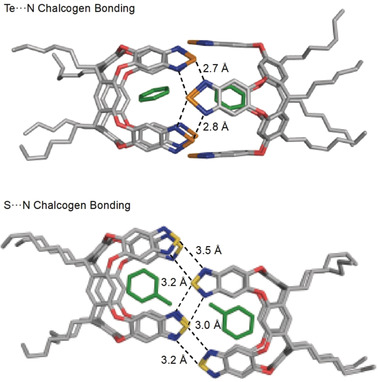
Strengths and weaknesses: Dimeric chalcogen-bonding capsules display a distinct behavior depending on the association strength, as shown by X-ray structures and confirmed by NMR spectroscopy solution studies. While capsules based on weak S⋅⋅⋅N interactions rely on solvation and the associated hemisphere preorganization, capsular assemblies formed by strong Te⋅⋅⋅N interactions are beyond external influences.




